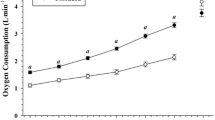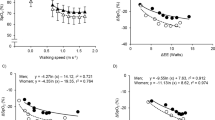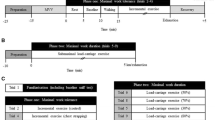Abstract
In this study, we compared the biomechanical and physiological responses of healthy men and women during bilateral load carriage while they walked on a treadmill at their self-selected velocity. Eleven men mean (SD) maximal oxygen uptake, [V˙O2 max = 56.0 (7.1) ml · kg−1 · min−1] and 11 women [V˙O2 max = 44.6 (7.6) ml · kg−1 · min−1] carried 15-kg and 20-kg loads in random order using a custom-designed load-carriage device. The load supported by each hand was measured by placing strain gauges in each handle of the device. The load supported by the body was calculated as the difference between the load carried and that supported by each hand. Physiological measurements were recorded using standard procedures, and cardiac output was measured by carbon dioxide rebreathing while standing, walking, and during load carriage. Three-way analysis of variance (gender by load by test phase) indicated no significant (P > 0.05) three-way interaction, implying that the overall trend in these responses was similar in men and women. A-priori Scheffe multiple comparisons revealed the following significant (P < 0.05) gender differences during load carriage: (1) women supported a lower proportion of the load with the hands and transferred a greater amount to the body by resting the load against the chest, (2) the oxygen uptake increased by a greater amount in the women compared with men and exceeded the ventilatory threshold during the 20-kg walk in women, and (3) the cardiovascular stress, as indicated by the percentage of maximal heart rate and rate pressure product (product of heart rate and systolic blood pressure), was significantly higher in women compared with men during both of the load-carriage walks. These observations suggest that when carrying absolute loads of 15 kg and 20 kg, women are more susceptible to fatigue and are at a greater risk of cardiovascular complications than men.
Similar content being viewed by others
Author information
Authors and Affiliations
Additional information
Accepted: 18 June 1999
Rights and permissions
About this article
Cite this article
Bhambhani, Y., Maikala, R. Gender differences during treadmill walking with graded loads: biomechanical and physiological comparisons. Eur J Appl Physiol 81, 75–83 (2000). https://doi.org/10.1007/PL00013800
Issue Date:
DOI: https://doi.org/10.1007/PL00013800




